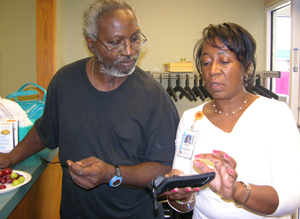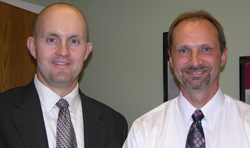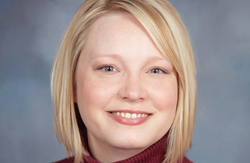 |
Diabetes education nurse Carolyn Cotton, right, shows Jack Jasper how to use a glucose meter kit at the UNMC Physicians Turner Park Clinic, which now operates under the medical home model of care. |
Care often is administered by a fragmented group of physicians and specialists who struggle to communicate with each other about a patient’s needs.
“We have many receivers running around but often no one is in charge to run the show,” said Dr. Klassen, chairman of the UNMC Department of Internal Medicine.
But a method of care currently in use at the resident-run UNMC Physicians Turner Park Clinic bypasses this scenario and could revolutionize health care in the United States.
The care model — known as the “medical home” — was adopted last fall by the Turner Park Clinic. It is one of the first clinics in the nation to use the model to train residents.
|
- A physician, who serves as team leader;
- A nurse;
- A pharmacist;
- A psychiatrist;
- A social worker;
- A nutritionist; and
- A physical therapist.
In this model, patients experience more frequent encounters with teams of providers — even if the patients are not sick. They receive more education to improve health and the health care team closely monitors health outcomes.
“This is a very important, innovative model of care,” Dr. Klassen said. “The medical home is a more comprehensive, patient-oriented team approach to health care compared to what we have now.”
The medical home model is heralded by many as a patient-orientated solution to much of what ails U.S. health care.
Rob Schwab, M.D., assistant professor in the UNMC Department of Internal Medicine, is director of the medical home project at Turner Park.
“The main reason for the medical home concept is better care so we can keep patients out of the hospital and emergency room,” Dr. Schwab said. “The trend is to improve quality of care — within the entire health care system we’ve done poorly.”
 |
From left: Chad Vokoun, M.D., and Robert Schwab, M.D., are among the UNMC faculty who help oversee the medical home project at Turner Park Clinic. Joel Bessmer, M.D., associate professor of internal medicine, also helps with the project. |
Dr. Klassen and Tom Tape, M.D., professor of internal medicine, deserve credit for forging ahead with the medical home model at Turner Park, Dr. Schwab said.
“They are very forward-thinking leaders who want to improve patient care,” he said. “They made a decision to pursue the concept in a clinic run by residents and nationally we are on the leading edge.”
The clinic’s resident leaders do the bulk of the work, Dr. Schwab said.
 |
Keely Hack, M.D., worked at Turner Park before and after the medical home approach was adopted. In less than a year, the care model has proven beneficial to patients and providers, she said. |
The clinic is one-third of the way into the process of creating the medical home and is focused currently on areas that will most benefit their patients.
Keely Hack, M.D., ambulatory care chief resident, UNMC Internal Medicine, and current chairwoman of the clinic’s board of directors, worked as a resident in Turner Park clinic before the medical home began and in the initial stages of its implementation.
She now is a part of the team of resident leaders for the project and said efforts already have paid off for patients and providers.
Based on a variety of data, she said, there seems to have been lower hospital readmission rates in their patient population since the medical home approach was adopted.
|
- Created a more user-friendly discharge instruction form that resident physicians review with patients and that patients can use as a reference once they are home; and
- Added the services of a part-time pharmacist who calls patients shortly after discharge to ensure proper medications and doses are taken.
Dr. Hack said within a few days of implementing this program, the clinic had patients with medication questions that, had they not been addressed quickly, could have led to readmission to the hospital.
“Things we do in the medical home require more time, but it’s crucial to patient safety and saving costs,” Dr. Hack said.